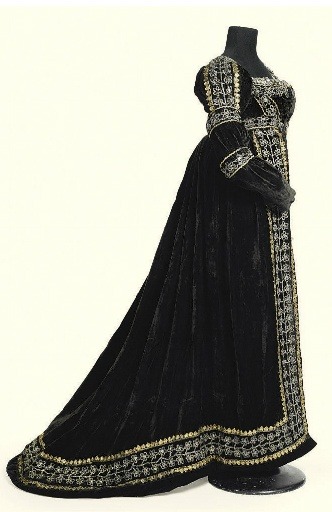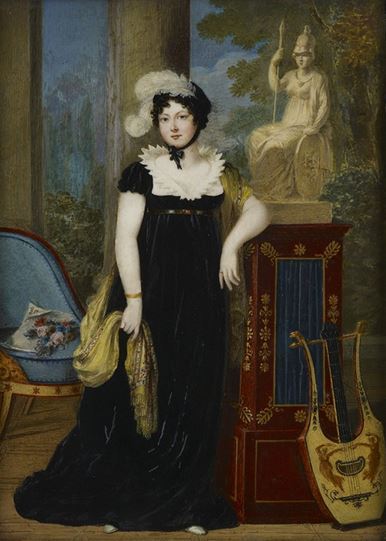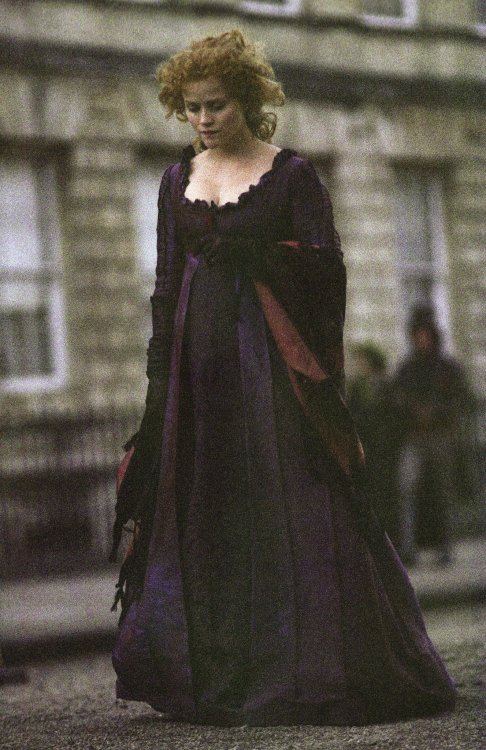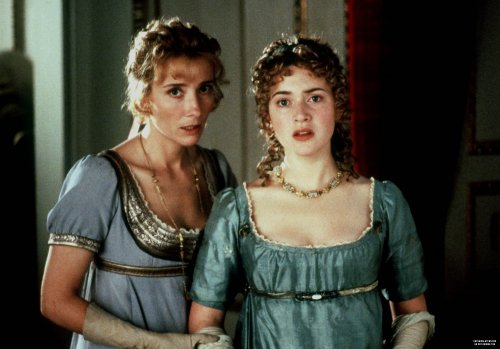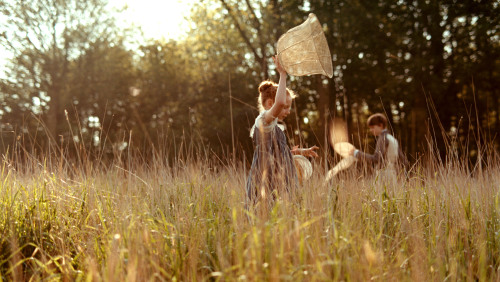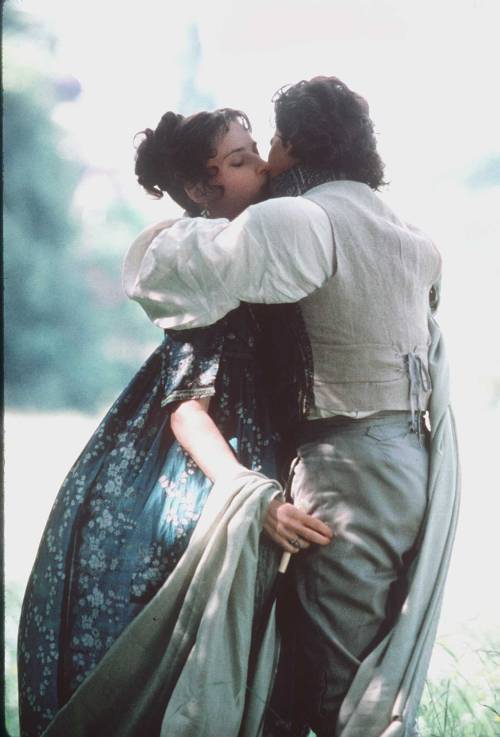#regency
1810 John James Masquerier - Two Sisters
My initial assumption was that the sister on the right was in mourning, but then I noticed the red ribbon on her sleeve and decided she was probably just a Goth.
Post link
Portrait of an Unknown Woman
Hippolyte-Jean Flandrin (1809–1864)
Flintshire Record Office
I usually post portraits that show off 19th century fashions better than this one does, but I like this one anyway. The unknown woman looks like she has a scheme in mind.
Post link
Fashion plate depicting a 1805 full dress, and a “dress of the old woman,” 1755.
The fashions of 2017 are different from the fashions of 1967, but the change between 1755 and 1805 may have been even greater, as shown in this illustration.
Ladies’ Museum, originally known as The Lady’s Monthly Museum, was a women’s magazine published from 1798 to 1828 or 1832.
Post link
“Portrait miniature of a woman (traditionally identified as Princess Henriette of Nassau-Weilburg”(c.1808).German School.
Post link
Close-up
Portrait miniature of Angelica Catalani (1815) by André-Léon Larue, called Mansion.
© The Royal Collection
Post link
Black organza Empire style dress, c. 1800-1810. From the Centre de Documentació i Museu Tèxtil, Barcelona, item #11898.
This seems quite daring – sleeveless AND a see-through bodice! – but I’m assuming it was meant to be worn over something else.
Post link
Evening dresses, 1810′s
From the exhibition "An Agreeable Tyrant: Fashion After the Revolution" at the DAR Museum
Post link
Evening dress ca. 1798-1800
From the DAR Museum
I’ve done some runs of color-themed fashion posts before, but realized I hadn’t tagged them. I doubt anyone cares but me, but I’m working on getting things tagged by color.
Post link
Le Bon Genre, No. 73, L’Egoisme personnifié. Hand-coloured etching. c. 1815. British Museum.
Description from the British Museum site:
Plate 73: a dandy leaning back negligently on a rush chair pokes one woman in the eye with his cane while hooking another’s dress with his spur.
Post link
This is crazy, but the Kickstarter is nearly over - nine hours left! If you want to get in on the preorders for Dandies & Dandyzettes, you’ll need to act fast!

We are also about $300 away from the last stretch goal, and it would be amazing if we could get it! It’s for a second large-scale illustration by @suburbanbeatnik - the sketch for the first is below:

Please help me afford another!


We’ve hit the first stretch goal! Now the previously planned portrait miniatures representing different classes will all be paired.
We already have the first pendant - the very handsome aristocrat pictured above! I cannot wait to see what @suburbanbeatnik comes up with for the other four.
If you haven’t joined in on the Kickstarter for Dandies & Dandyzettesyet,it’s right here! The book will be available in a bunch of different formats and different price points, so it works for any budget.
The next stretch goal, which we’ll be reaching soon, will be a detail map of the city of Bath to facilitate games or stories set there. Can’t wait!
I see Tumblr is cropping long posts now, so -
The Kickstarter is live!

Let me show off some of the beautiful art by @suburbanbeatnik:

These miniature portraits will be appearing in the book alongside the discussion of different social classes - aristocracy, landed gentry, military, clergy, and trade.
The Kickstarter is actually fully funded, but now we’re looking at hitting the first stretch goal to have these each paired with another of a different gender!
So please do check it out - there are lots of rewards at various price points, from the digital copy at $7 to the opportunity to put yourself into an illustration at $500 (and beyond)!
An answer to an AskHistorians question about first names in Jane Austen! From the question text: At home, Elizabeth is called ‘Lizzie’ by her family. Her friends and acquaintances (same gender) sometimes call her Miss Elizabeth Bennett, sometimes Miss Eliza Bennett, and in Charlotte’s case, just plain Eliza. Mr Darcy never calls her Elizabeth until he proposes the second time (Dearest, loveliest Elizabeth). I figured that was to do with permissible familiarity. But Elizabeth’s parents never refer to each other by first name. Is that because they’re in the presence of their children, or is it an indication of the (lack of) warmth in their relationship? That’s without even getting into 'Emma’, and the affront around Knightley and Mr E.
I just want to make a bit of a correction - Elizabeth’s family calls her “Lizzy”, and “Eliza”/“Miss Eliza Bennet” are used specifically by the Lucas family, and Caroline Bingley. Mr Darcy’s second proposal, in the original text, is simply:
You are too generous to trifle with me. If your feelings are still what they were last April, tell me so at once. My affections and wishes are unchanged, but one word from you will silence me on this subject for ever.
First names were highly familiar, and not to be used lightly. To use someone else’s first name was to show that you were extremely close - which didn’t necessarily mean there was a long acquaintance. By the second chapter of Isabella Thorpe’s appearance in Northanger Abbey,
… they passed so rapidly through every gradation of increasing tenderness that there was shortly no fresh proof of it to be given to their friends or themselves. They called each other by their Christian name, were always arm in arm when they walked, pinned up each other’s train for the dance, and were not to be divided in the set; and if a rainy morning deprived them of other enjoyments, they were still resolute in meeting in defiance of dirt and wet, and shut themselves up, to read novels together.
On the other hand, in Pride and Prejudice the Lucases are the Bennets’ closest and long-time associates in the immediate neighborhood, so it makes sense that the families are on close enough footing for the Lucases as a whole to refer to the Bennet daughters by their first names.
However, it was certainly possible to be over-familiar - and many travelogues by English people who’d gone abroad contain a shocked description of how people in America, Spain, Germany, etc. jump so quickly to a first name basis. From this perspective, Caroline Bingley’s use of “Eliza” can be seen as having been likely intended to be presumptuous, highlighting the unpleasantness of her character: she is neither a long acquaintance like Charlotte and Maria Lucas, nor is she abruptly becoming Elizabeth’s best friend.
The rules were slightly different for men. While family members would use their first names (as the Dashwood sisters do for their brother-in-law Edward Ferrars), the “friendship name”, generally just used between two men, was instead the last name - as in Emma, with Mrs. Elton calling Mr Knightley just “Knightley”. Just like Caroline Bingley, she is written as doing this so we can see her presumption - although while Caroline’s presumption is condescending (“see, I can be over-familiar and you can’t do anything about it”), Mrs. Elton is, on the contrary, trying to put herself up on Mr Knightley’s level and show everyone else that she’s on such terms with the preeminent landowner of the area.
“Miss Elizabeth Bennet” is a special case. In a family with multiple sons or daughters, the first would be “Miss Bennet” or “Mr Bennet”, and the younger ones would be “Miss Elizabeth Bennet” or “Mr Charles Bennet”. In direct address, however, a simple “Miss Bennet” or “Mr Bennet” would still be appropriate for a younger daughter or son. The main point of all of this was just for the purpose of clarity - if Jane were to have gotten married early on in the book, for instance, there would have been no need for anyone to refer to Elizabeth’s first name in this kind of title, as she would obviously be the “Miss Bennet”.
As far as married couples go, both first names and Mr/Mrs seem to have been somewhat normalized - neither was actually notable or strange in the period, but yes, would reflect the level of formality/intimacy between the couple, as well as where they are. In Sense and Sensibility, John Dashwood calls his wife “Fanny”, and in Persuasion, Mary calls her husband “Charles”; but as you noted, the Bennets call each other Mr/Mrs, and so do the Palmers in Sense and Sensibility. However, we only really see first-naming between husbands and wives in fairly private settings - in a domestic group, or just between each other. In public, it was not seen as appropriate to be too informal. As a result, the general public wouldn’t know if a couple were not on the closest footing because they would never have been witness to a married couple using their first names.
Transgressions would likely not be punished in a real sense, but would result in negative consequences of the “two red minus signs above the sim’s head” sense. When Caroline calls Elizabeth “Eliza”, it makes Elizabeth dislike her. When Mrs. Elton calls Mr Knightley “Knightley”, she makes the people around her think less of her.
You’ll find more of this kind of Regency etiquette nitpickery in Dandies & Dandyzettes!




